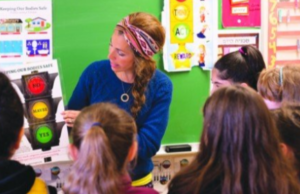
If you think teaching your young child stranger danger might make them fearful of people, this article explains why you’re mistaken.
Some parents worry that teaching their young kids about “stranger safety” will cause them to be afraid of any new person they might meet.
Yet at the same time, smart parents realize that children should be taught the guidelines when it comes to strangers.
So let’s look at it this way: If you’re a woman, have you ever taken self-defense or attended a seminar on safety?
Perhaps you learned don’t walk alone at night in a public garage; don’t enter an elevator alone if a creepy looking man is inside; etc.
Has this turned you into a blob of fear who’s afraid to talk to men? Of course not.
Likewise, kids will not develop social anxiety, or become paranoid or fearful of people if they’re taught stranger safety (a.k.a. stranger danger).
“By teaching our children these rules [e.g., run if a stranger in the park approaches you] we do not make them more paranoid, and that is a ridiculous notion,” says Dr. Shani Verschleiser, Founder and CEO of Magenu, a non-profit organization that creates and implements educational curriculums dedicated to empowering children in personal safety and awareness.
“When a child is prepared they are less anxious because they have a plan of action.
“We would never not teach a child to stay away from fire from fear that they will have anxiety over it. We are not teaching our children that all people are bad.”
The fire is a good analogy. What child develops a fear of cooking, cookouts and roasting marshmallows over a fire as a result of being taught fire dangers?
Dr. Verschleiser further explains that children respond very well to the rules of stranger safety.
She adds, “There was a story that was told (I don’t remember where I read it) of two kids who were in the same class when there were gunshots by their classroom.
“One kid was trained in earthquake drills, and when he heard the sound, immediately thought of that and got under his desk and came out of the experience fine.
“The other kid was not trained and was completely panicked; he came out with major trauma and needed counseling.
“The only difference was being prepared for an emergency. This type of training is preparing for emergencies.”
Social anxiety usually begins in the early to mid-teen years and has the following risk factors:
Family history. A child is more likely to be fearful of people if a parent of sibling has this problem.
Negative experiences. This refers to being bullied, harassed, rejected, sexually abused or in a conflicted family environment.
Temperament. Children who have always been shy, quiet and timid — long before the stranger danger lessons begin.
Health condition. This can be a disfigurement, speech impediment, limp, etc.
Parents may also want to discuss the effect of teaching stranger safety with their child’s pediatrician.
Ask parents of socially impaired children if their kids became fearful of people only AFTER they were given intensive awareness training in stranger safety.
You’ll find that coaching in stranger awareness had nothing to do with the child’s social challenges.










































